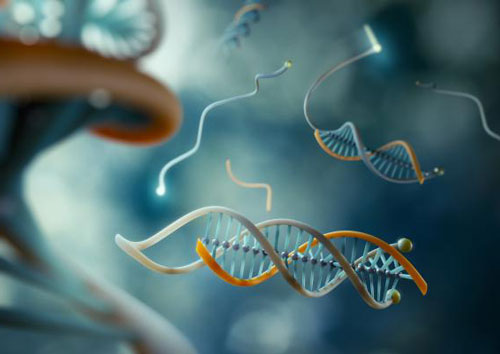Nanomedicine
Nanomedicine is a field of medicine that utilizes nanotechnology to improve the diagnosis, treatment, and prevention of diseases. It encompasses various applications, including the use of nanoscale materials and devices to enhance medical outcomes.
Nanomedicine is seen as a critical tool for advancing personalized, targeted, and regenerative medicine. It holds the potential to bring new drugs, treatments, and implantable devices to healthcare providers and patients, resulting in significant advancements in the field.
For example, in the case of cancer diagnosis, nanotechnology can be used to develop biosensors that can detect biomarkers in the blood or tissues. This helps to identify the presence of the disease at an early stage, leading to more effective treatment.
Another example is in the field of tissue engineering, where nanotechnology can be used to design and construct artificial tissues and organs for transplants. This can help overcome the shortage of donor organs and improve the quality of life for patients.
In the field of drug delivery, nanoparticles can be designed to target specific cells or tissues. For instance, in the treatment of cancer, chemotherapy drugs can be delivered directly to the tumor, reducing the exposure of the rest of the body and minimizing side effects.
Moreover, nanomedicine formulations can reduce the frequency of medication intake. For example, the treatment for age-related macular degeneration requires monthly injections, but using nanotechnology, it can be reduced to once every 6 months. Nanoparticles biodegrade into natural components that can be easily removed from the body after the medication has been delivered.

Nanotechnology in healthcare not only has the potential to change medical science dramatically and as part of beneficial nanotechnology in developing countries, but to open a new field of human enhancements that is poised to add a profound and complex set of ethical questions for health care professionals.
For instance, there is a fine line between medical and non-medical uses of nanotechnology for diagnostic, therapeutic and preventive purposes (e.g. non-medical implants in soldiers). The question of whether nanotechnology should be used to make intentional changes in or to the body when the change is not medically necessary is just one hot topic in a long list of concerns.
According to an expert group of the European Medicines Evaluation Agency Source ("Reflection paper on nanotechnology-based medicinal products for human use"), "the majority of current commercial applications of nanotechnology to medicine is geared towards drug delivery to enable new modes of action, as well as better targeting and bioavailability of existing medicinal substances. Novel applications of nanotechnology include nanostructure scaffolds for tissue replacement, nanostructures that allow transport across biological barriers, remote control of nanoprobes, integrated implantable sensory nanoelectronic systems and multifunctional chemical structures for drug delivery and targeting of disease."
The medical advances that may be possible through nanotechnology range from diagnostic to therapeutic, and everything in between (also check out our primer How does nanotechnology work). A recent ObservatoryNano report lists nanotechnological applications in health and medicine (pdf). The two main areas in nanomedicine are:
Nanomedicine Diagnostics
In the past few decades, imaging has become a critical tool in the diagnosis of disease. The advances in the form of magnetic resonance and computer tomography are remarkable, but nanotechnology promises sensitive and extremely accurate tools for in vitro and in vivo diagnostics far beyond the reach of today's state-of-the-art equipment.
As with any advance in diagnostics, the ultimate goal is to enable physicians to identify a disease as early as possible. Nanotechnology is expected to make diagnosis possible at the cellular and even the sub-cellular level.
Quantum dots in particular have finally taken the step from pure demonstration experiments to real applications in imaging. In recent years, scientists have discovered that these nanocrystals can enable researchers to study cell processes at the level of a single molecule. This may significantly improve the diagnosis and treatment of cancers.
Fluorescent semiconductor quantum dots are proving to be extremely beneficial for medical applications, such as high-resolution cellular imaging. While quantum dots could revolutionize medicine, unfortunately, most are toxic. However, recent studies conducted at the University of California, Berkeley, have shown that protective coatings for quantum dots may eliminate toxicity.
Nanomedicine Therapy
In terms of therapy, the most significant impact of nanomedicine is expected to be realized in drug delivery and regenerative medicine. Nanoparticles enable physicians to target drugs at the source of the disease, which increases efficiency and minimizes side effects. They also offer new possibilities for the controlled release of therapeutic substances. Nanoparticles are also used to stimulate the body's innate repair mechanisms. A major focus of this research is artificial activation and control of adult stem cells.
Peptide amphiphiles that support cell growth to treat spinal cord injury; magnetic nanoparticles and enzyme-sensitive nanoparticle coatings that target brain tumors; smart nanoparticle probes for intracellular drug delivery and gene expression imaging, and quantum dots that detect and quantify human breast cancer biomarkers are just a few of the advances researchers have already made.
Interestingly enough, there could be massive shifts in economic value among pharmaceutical companies. While the new nanomedicines open up enormous market and profit potentials, entire classes of existing pharmaceuticals such as chemotherapy agents worth billions of dollars in annual revenue would be displaced.
Other areas that are increasingly attracting interest from nanotechnology researchers are tissue engineering, nanosurgery, and nanoparticle-enabled diagnostics and drug delivery (read more: "A closer look at nanomedicine").
Also take an up-to-date look at how nanoelectronics will change medicine.
Nanotechnology to cure diseases has many potential impacts on cancer research, especially cancer drugs. In particular, this technology can help facilitate research and improve molecular imaging, early detection, prevention, and treatment of cancer. Read more: Nanotechnology and cancer medicine.
Nanotechnology to Cure Diseases
There are plenty of examples where nanotechnology is being applied to cure cancer and other diseases. Here are some recent ones:
Dendrimer nanomedicine – developing efficient therapeutic strategies for the treatment of neurological disorders
